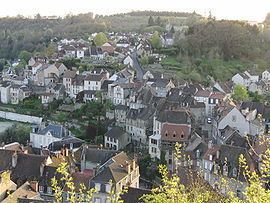Area 19.21 km² | Local time Wednesday 10:39 AM | |
 | ||
Weather 6°C, Wind SW at 21 km/h, 85% Humidity | ||
Aubusson ([o.by.sɔ̃]; Occitan auvergnat: Le Buçon, formerly Aubuçon) is a commune in the Creuse department region in central France.
Contents
- Map of 23200 Aubusson France
- Geography
- History
- Tapestry
- Muse Dpartemental de la Tapisserie
- Maison du Tapissier
- Historical buildings
- Rulers
- Personalities
- International relations
- References
Map of 23200 Aubusson, France
Geography
Aubusson is situated in the southern part of the département, at the confluence of the Creuse River and the Beauze. The route nationale N141 goes through the town.
History
Local lore previously held that the community was settled by defeated Berbers following the 8th-century Battle of Tours, but it is now established that Aubusson has existed at least since the Gallo-Roman period. The Camp des Châtres, within the town’s boundaries, for a long time considered a Roman fort, actually dates back a little further, to the Iron Age.
The town was known as Albuciensis in 936 and under the name Albuconis in 1070. The name possibly originates from a name of a man, Albucius Other scholars claim the name is from a Celtic word meaning craggy. In the Middle Ages the town was ruled by viscounts. The vicecomital family also produced a troubadour named Joan d'Aubusson.
Tapestry
Aubusson is well known for its tapestry and carpets, which have been famous throughout the world since the 14th century. Its origins were born with the arrival of weavers from Flanders, who took refuge in Aubusson around 1580. There is a famous collection of Aubusson tapestries at Vallon-Pont-d'Arc. The style of the tapestries produced has changed through the centuries, from scenes of green landscapes through to hunting scenes. In the 17th Century, the Aubusson and Felletin workshops were given "Royal Appointment" status. A downturn in fortunes came after the French revolution and the arrival of wallpaper. However, tapestry made something of a comeback during the 1930s, with artists such as Cocteau, Dufy, Dali, Braque, Calder and Picasso being invited to Aubusson to express themselves through the medium of wool. Aubusson tapestry still thrives today, preserving a range of traditional skills. In 1983, l’Atelier Raymond Picaud chose Burhan Doğançay's Ribbon Series as a tapestry subject. Coventry cathedral's famous Christ in Glory tapestry, designed by artist Graham Sutherland, was woven in nearby Felletin. Installed in 1962, this was the world's largest vertical tapestry up until the 1990s.
Musée Départemental de la Tapisserie
Created in 1981, the museum exhibits nearly 600 years of tapestry creation and production. This rich collection is composed of 17th, 18th and 19th Century tapestries and carpets. As well as works from its own collection, there are also regular exhibitions of tapestries from around the world, showcasing works right up to the present day.
Maison du Tapissier
This is a permanent exhibition that is staged in an ancient Creusois house in Aubusson. The interior tells the history and traditions of tapestry as well as showing furniture of the period.
Historical buildings
Rulers
In the medieval period, Aubusson was a vice-county. Its rulers were:
Around 1263/1266 the vice-county was sold to the count of La Marche.
Personalities
Two contemporary political figures Aubussonnaises distant origins. This is Philippe de Villiers, one grandfather, Guy of Plantadis was lord of Aubusson, and Michel Sapin counts in his mother genealogy several families of weavers and notables of the city, such as "Chaussat "the" Montlucon ", the" Rebière "or" the Seiglière. "Finally, Georges Sarre and Michel Pinton come from several families around Aubusson and were born respectively in Chénérailles and Felletin towns in the district of Aubusson.
International relations
Aubusson is twinned with:
